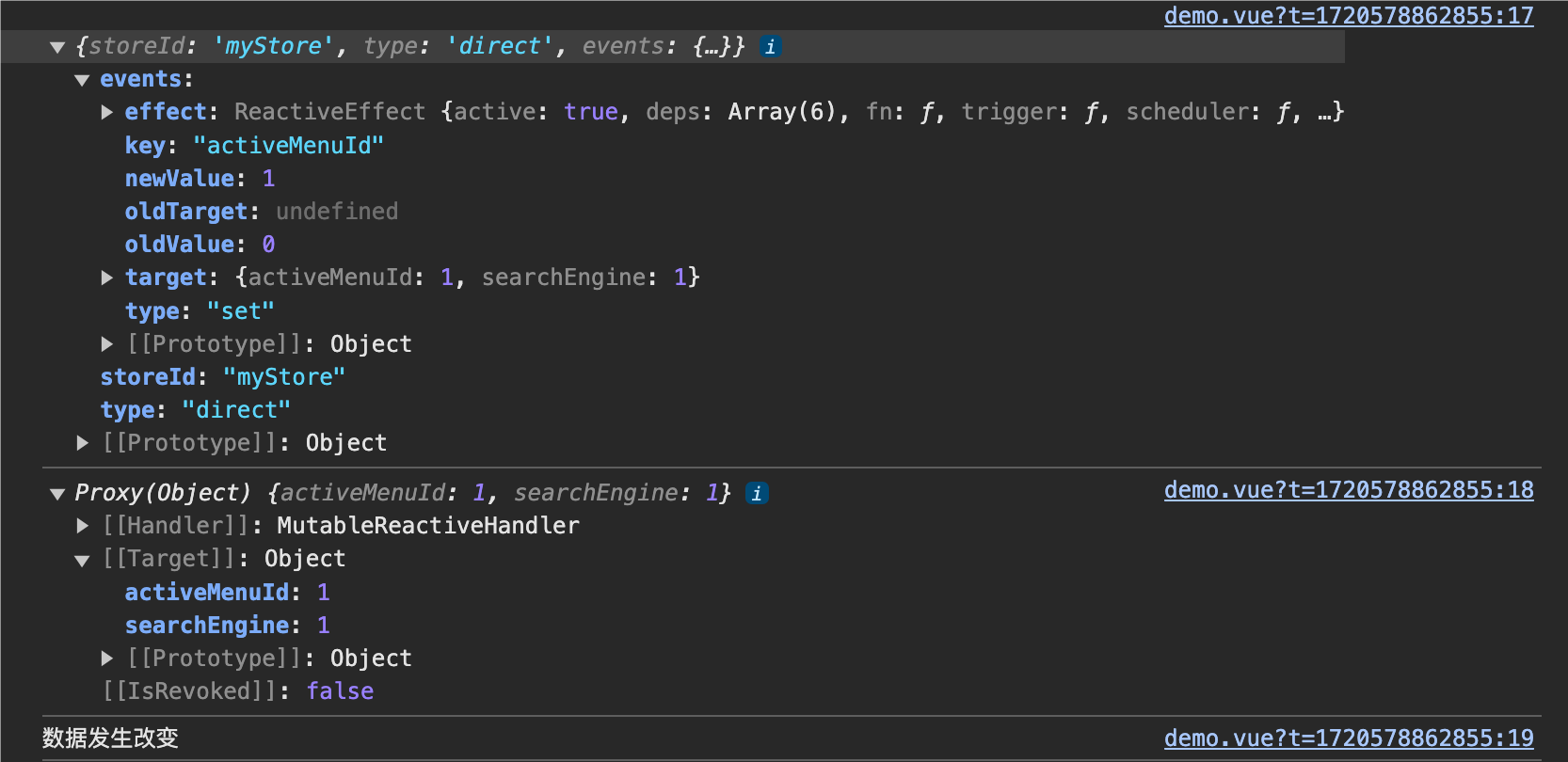外观
Skip to content
此页内容
Vue3-Pinia
耶温
1619字约5分钟
2024-06-23
Vue3-Pinia
符合直觉的Vue.js 状态管理库。
- 所见即所得:与组件类似的 Store。其 API 的设计旨在让你编写出更易组织的 store。
- 类型安全:类型可自动推断,即使在 JavaScript 中亦可为你提供自动补全功能
- 开发工具支持:不管是 Vue 2 还是 Vue 3,支持 Vue devtools 钩子的 Pinia 都能给你更好的开发体验。
- 可扩展性:可通过事务、同步本地存储等方式扩展 Pinia,以响应 store 的变更以及 action。
- 模块化设计:可构建多个 Store 并允许你的打包工具自动拆分它们。
- 极致轻量化:Pinia 大小只有 1kb 左右,你甚至可能忘记它的存在!
安装Pinia
npm install piniamain.ts
import { createApp } from 'vue'
import App from './App.vue'
// 引入
import { createPinia } from 'pinia'
import router from "./router/index";
const app = createApp(App)
// 创建pinia
const pinia = createPinia()
// 加载pinia
app.use(pinia)
app.use(router)
app.mount('#app')储存读取数据
创建store相关文件,存放数据。
store/useUserStore.ts:
// 引入pinia
import { defineStore } from "pinia";
// 定义 store 的状态类型
interface MyState {
activeMenuId: number;
searchEngine: number;
}
// 创建 store
export const useUserStoreHook = defineStore({
id: "myStore", // 必须是唯一的字符串 ID
state: (): MyState => ({
activeMenuId: 1,
searchEngine: 1,
}),
getters: {},
actions: {},
});使用数据
<template>
<div>当前 activeMenuId:{{ userStore.activeMenuId }}</div>
<div>当前 searchEngine:{{ userStore.searchEngine }}</div>
</template>
<script setup lang="ts" name="demo">
import { useUserStoreHook } from "@/store/useUserStore";
const userStore = useUserStoreHook();
// or let { activeMenuId, searchEngine } = useUserStoreHook()
</script>在上面示例中,我们通过一个变量直接接受了所有的Store数据。其实还可以通过解构let { activeMenuId, searchEngine } = useUserStoreHook(),来获取特定的数据。但需要注意的是,通过解构获取的数据不是响应式的,需要做额外处理,将在下面解决该问题。
修改数据
直接修改
<template>
<div>当前 activeMenuId:{{ userStore.activeMenuId }}</div>
<div>当前 searchEngine:{{ userStore.searchEngine }}</div>
<button @click="changeData">改变数据</button>
</template>
<script setup lang="ts" name="demo">
import { useUserStoreHook } from "@/store/useUserStore";
const userStore = useUserStoreHook();
function changeData() {
userStore.activeMenuId = userStore.activeMenuId + 1
userStore.searchEngine++
}
</script>和Vue2中的Vuex不同,在pinia中当我们通过const userStore = useUserStoreHook();获取数据时,也可以通过userStore直接修改数据。如果通过解构获取的数据,则不能直接修改。
patch修改
<template>
<div>当前 activeMenuId:{{ userStore.activeMenuId }}</div>
<div>当前 searchEngine:{{ userStore.searchEngine }}</div>
<button @click="changeData">改变数据</button>
</template>
<script setup lang="ts" name="demo">
import { useUserStoreHook } from "@/store/useUserStore";
const userStore = useUserStoreHook();
function changeData() {
userStore.$patch({
activeMenuId: userStore.activeMenuId + 1,
searchEngine: userStore.activeMenuId + 1
})
}
</script>我们可以借助Pinia的内置方法$patch(),快速修改多个属性的值。
actions修改
使用actions方法修改数据,需要在对应的store文件中提前定义。
store/useUserStore.ts:
// 引入pinia
import { defineStore } from "pinia";
// 定义 store 的状态类型
interface MyState {
activeMenuId: number;
searchEngine: number;
}
// 创建 store
export const useUserStoreHook = defineStore({
id: "myStore", // 必须是唯一的字符串 ID
state: (): MyState => ({
activeMenuId: 0,
searchEngine: 0,
}),
getters: {},
actions: {
changeActiveMenuId(value: number) {
if (this.activeMenuId < 10) {
this.activeMenuId = value
}
},
async initData(){
// 请求接口
const res = await new Promise<{activeMenuId: number, searchEngine: number}>((resolve, reject) => {
setTimeout(()=>{
resolve({
activeMenuId:1,
searchEngine:1,
})
},1000)
})
if(res){
this.activeMenuId = res.activeMenuId
this.searchEngine = res.searchEngine
}
},
},
});我们在上面文件中actions中定义了两个方法,initData用来调用接口初始化数据,changeActiveMenuId用来实时更改数据,并且可以做一些处理和限制。方法的具体使用方法如下:
<template>
<div>当前 activeMenuId:{{ userStore.activeMenuId }}</div>
<div>当前 searchEngine:{{ userStore.searchEngine }}</div>
<button @click="changeData">改变数据</button>
</template>
<script setup lang="ts" name="demo">
import { useUserStoreHook } from "@/store/useUserStore";
import { watchEffect } from "vue";
const userStore = useUserStoreHook();
// 初始化数据
userStore.initData()
// 按钮修改数据
function changeData() {
userStore.changeActiveMenuId(5)
}
</script>ToRefs和storeToRefs
在上文中我们有提到,在使用store中数据时,可以通过解构获取特定的数据(let { activeMenuId, searchEngine } = useUserStoreHook()),但是会丢失响应式状态。
我们现在可以借助ToRefs和storeToRefs方法,使其重新获取响应式状态。
具体使用如下:
<template>
<div>当前 activeMenuId:{{ activeMenuId }}</div>
<div>当前 searchEngine:{{ searchEngine }}</div>
<button @click="changeData">改变数据</button>
</template>
<script setup lang="ts" name="demo">
import { useUserStoreHook } from "@/store/useUserStore";
import { storeToRefs } from "pinia";
import { toRefs } from "vue";
const userStore = useUserStoreHook();
let { activeMenuId, searchEngine } = storeToRefs(userStore)
// or let { activeMenuId, searchEngine } = toRefs(userStore)
let num = 0
function changeData() {
num++
userStore.changeActiveMenuId(num)
}
</script>如上文代码所示,虽然ToRefs和storeToRefs都能使其重新获取响应式状态。但是在我们日常使用中,更推荐使用storeToRefs。
这是因为:pinia提供的storeToRefs只会将数据(state)做转换,而Vue的toRefs会转换store中所有数据和方法(state、actions等)。包括而我们往往只需要数据的响应式状态。
getters
当state中的数据,需要经过处理后再使用时,可以使用getters配置。一般我们用作对于数据的加工改造,类似于Vue中的计算属性。具体使用如下文示例:
store/useUserStore.ts:
// 引入pinia
import { defineStore } from "pinia";
// 定义 store 的状态类型
interface MyState {
activeMenuId: number;
searchEngine: number;
}
// 创建 store
export const useUserStoreHook = defineStore({
id: "myStore", // 必须是唯一的字符串 ID
state: (): MyState => ({
activeMenuId: 0,
searchEngine: 0,
}),
getters: {
// 不使用this的话 可以直接使用箭头函数
activeMenuIdStr:state=>('当前选择:' + state.activeMenuId),
activeEngineStr():string{
return '当前引擎:' + this.activeMenuId
}
},
actions: {
},
});使用:
<template>
<div>{{ userStore.activeMenuIdStr }}</div>
<div>{{ userStore.activeEngineStr }}</div>
<button @click="changeData">改变数据</button>
</template>
<script setup lang="ts" name="demo">
import { useUserStoreHook } from "@/store/useUserStore";
const userStore = useUserStoreHook();
function changeData() {
userStore.activeMenuId++
userStore.searchEngine++
}
</script>$subscribe
$subscribe方法,相当于vue中的watch,可以监听store中数据的变化。该方法接受一个回调函数参数。回调函数有两个参数,第一个参数为本次修改的信息,第二个参数为当前的数据。
具体使用方式如下:
<template>
<div>{{ userStore.activeMenuIdStr }}</div>
<div>{{ userStore.activeEngineStr }}</div>
<button @click="changeData">改变数据</button>
</template>
<script setup lang="ts" name="demo">
import { useUserStoreHook } from "@/store/useUserStore";
const userStore = useUserStoreHook();
function changeData() {
userStore.activeMenuId++
userStore.searchEngine++
}
userStore.$subscribe((mutate,state) => {
console.log(mutate)
console.log(state)
console.log('数据发生改变')
})
</script>打印输出: 
组合式示例
// 引入pinia
import { defineStore } from "pinia";
import { ref, computed } from "vue";
// 创建 store
export const useUserStoreHook = defineStore('myStore', () => {
let activeMenuId = ref(0);
let searchEngine = ref(0);
// 数据处理
let activeMenuIdStr = computed(() => {
return '当前引擎:' + activeMenuId.value
})
let searchEngineStr = computed(() => {
return '当前引擎:' + searchEngine.value
})
// 初始化数据
async function initData() {
// 请求接口
const res = await new Promise<{ activeMenuId: number, searchEngine: number }>((resolve, reject) => {
setTimeout(() => {
resolve({
activeMenuId: 1,
searchEngine: 1,
})
}, 1000)
})
if (res) {
activeMenuId.value = res.activeMenuId
searchEngine.value = res.searchEngine
}
}
return {
activeMenuId,
searchEngine,
activeMenuIdStr,
searchEngineStr,
initData
}
});如上面代码所示,我们可以使用更符合Vue3语法的组合式API来定义Store。我们不再需要在state中定义数据,可以在回调函数中直接定义数据和方法。需要注意的是,我们需要return出我们需要的数据和方法。对于Store中的getter方法,我们可以使用vue3中的计算属性(computed)代替。
